Managing Innovation in Business: A Report on Tesco's Strategies
VerifiedAdded on 2020/01/23
|20
|7140
|79
Report
AI Summary
This report provides an executive overview of Tesco's innovation management, focusing on its historical approach and current strategies. It discusses Tesco's adoption of innovative technologies like RFID and self-checkouts to enhance customer satisfaction, streamline operations, and gain a competitive edge in the retail market. The report details Tesco's innovation history, from its early days to its expansion into global markets and its embrace of technological advancements. It also assesses Tesco's existing innovation performance and capabilities, highlighting its focus on technological integration and customer-centric solutions. Furthermore, the report explores the future of the retail industry and Tesco's plans for future innovation, including sustainable practices and advanced automation. The report concludes by emphasizing the importance of innovation for Tesco's continued success and market leadership.
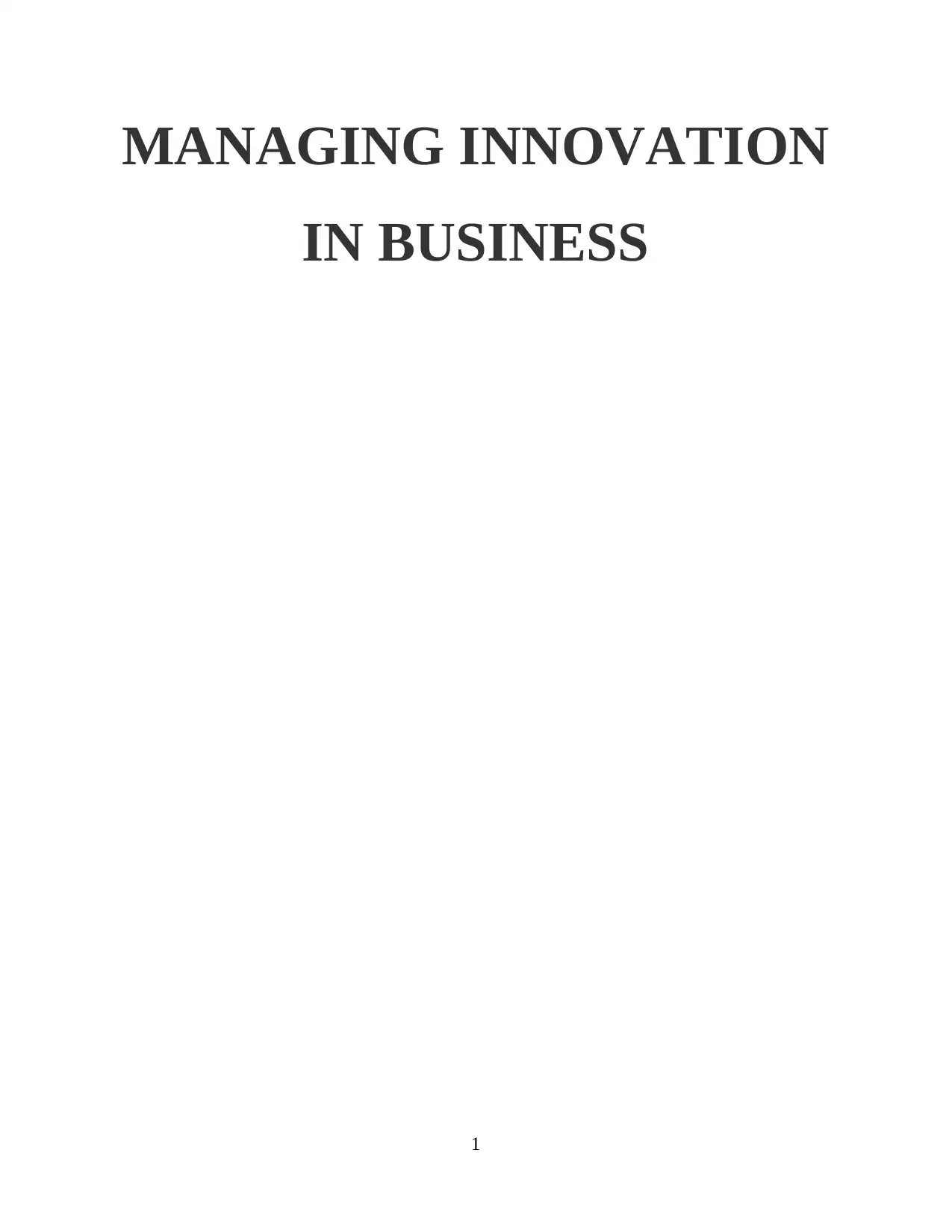
MANAGING INNOVATION
IN BUSINESS
1
IN BUSINESS
1
Paraphrase This Document
Need a fresh take? Get an instant paraphrase of this document with our AI Paraphraser
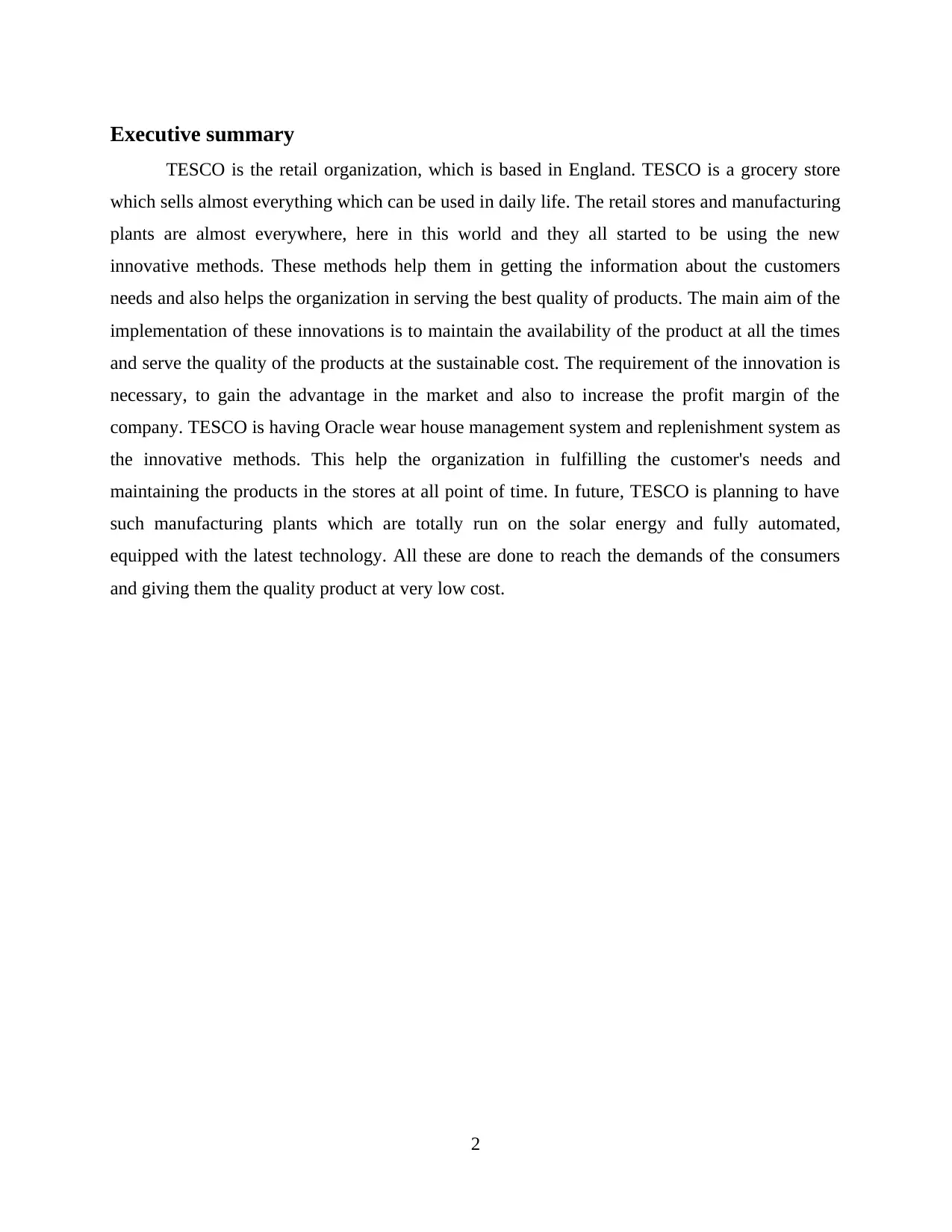
Executive summary
TESCO is the retail organization, which is based in England. TESCO is a grocery store
which sells almost everything which can be used in daily life. The retail stores and manufacturing
plants are almost everywhere, here in this world and they all started to be using the new
innovative methods. These methods help them in getting the information about the customers
needs and also helps the organization in serving the best quality of products. The main aim of the
implementation of these innovations is to maintain the availability of the product at all the times
and serve the quality of the products at the sustainable cost. The requirement of the innovation is
necessary, to gain the advantage in the market and also to increase the profit margin of the
company. TESCO is having Oracle wear house management system and replenishment system as
the innovative methods. This help the organization in fulfilling the customer's needs and
maintaining the products in the stores at all point of time. In future, TESCO is planning to have
such manufacturing plants which are totally run on the solar energy and fully automated,
equipped with the latest technology. All these are done to reach the demands of the consumers
and giving them the quality product at very low cost.
2
TESCO is the retail organization, which is based in England. TESCO is a grocery store
which sells almost everything which can be used in daily life. The retail stores and manufacturing
plants are almost everywhere, here in this world and they all started to be using the new
innovative methods. These methods help them in getting the information about the customers
needs and also helps the organization in serving the best quality of products. The main aim of the
implementation of these innovations is to maintain the availability of the product at all the times
and serve the quality of the products at the sustainable cost. The requirement of the innovation is
necessary, to gain the advantage in the market and also to increase the profit margin of the
company. TESCO is having Oracle wear house management system and replenishment system as
the innovative methods. This help the organization in fulfilling the customer's needs and
maintaining the products in the stores at all point of time. In future, TESCO is planning to have
such manufacturing plants which are totally run on the solar energy and fully automated,
equipped with the latest technology. All these are done to reach the demands of the consumers
and giving them the quality product at very low cost.
2
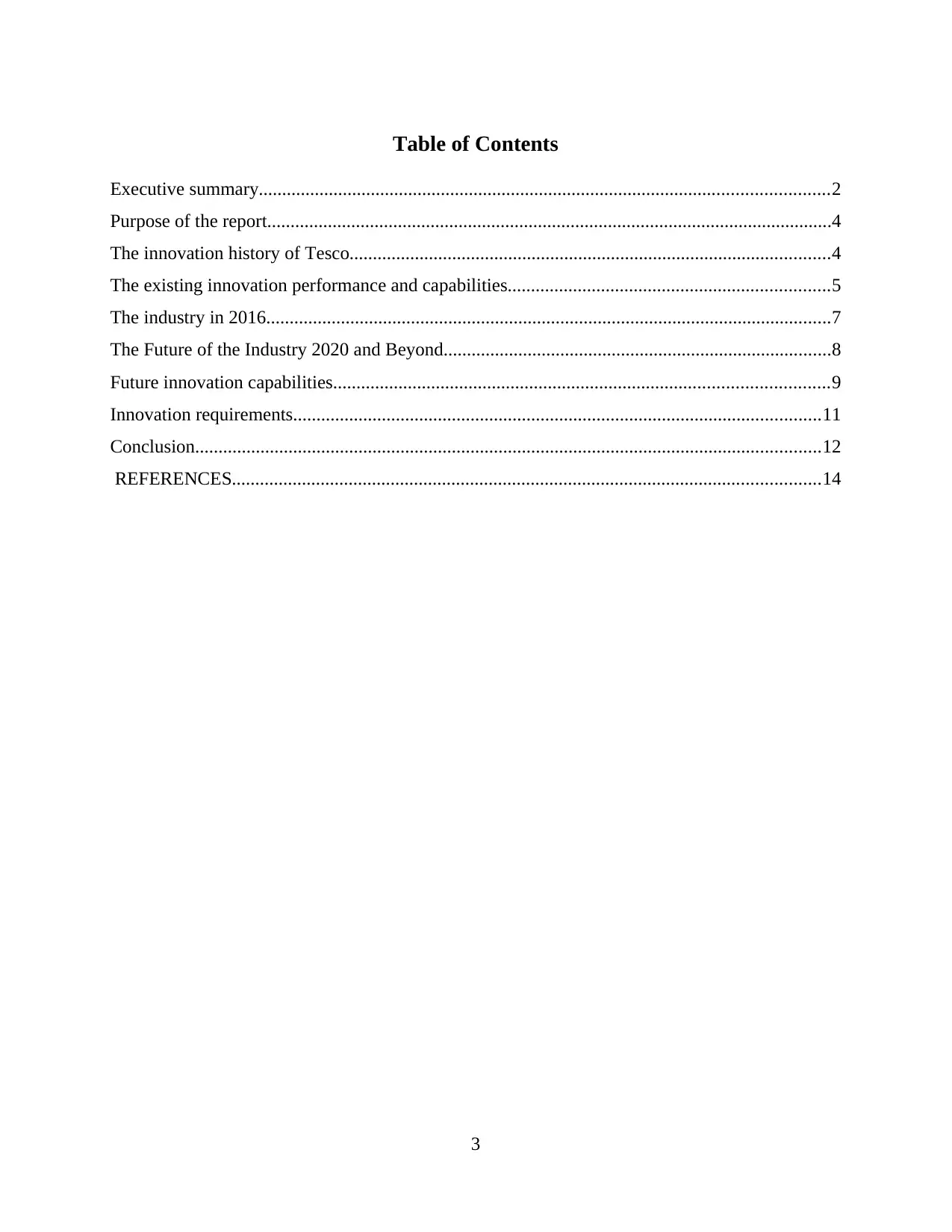
Table of Contents
Executive summary..........................................................................................................................2
Purpose of the report.........................................................................................................................4
The innovation history of Tesco.......................................................................................................4
The existing innovation performance and capabilities.....................................................................5
The industry in 2016.........................................................................................................................7
The Future of the Industry 2020 and Beyond...................................................................................8
Future innovation capabilities..........................................................................................................9
Innovation requirements.................................................................................................................11
Conclusion......................................................................................................................................12
REFERENCES..............................................................................................................................14
3
Executive summary..........................................................................................................................2
Purpose of the report.........................................................................................................................4
The innovation history of Tesco.......................................................................................................4
The existing innovation performance and capabilities.....................................................................5
The industry in 2016.........................................................................................................................7
The Future of the Industry 2020 and Beyond...................................................................................8
Future innovation capabilities..........................................................................................................9
Innovation requirements.................................................................................................................11
Conclusion......................................................................................................................................12
REFERENCES..............................................................................................................................14
3
⊘ This is a preview!⊘
Do you want full access?
Subscribe today to unlock all pages.

Trusted by 1+ million students worldwide
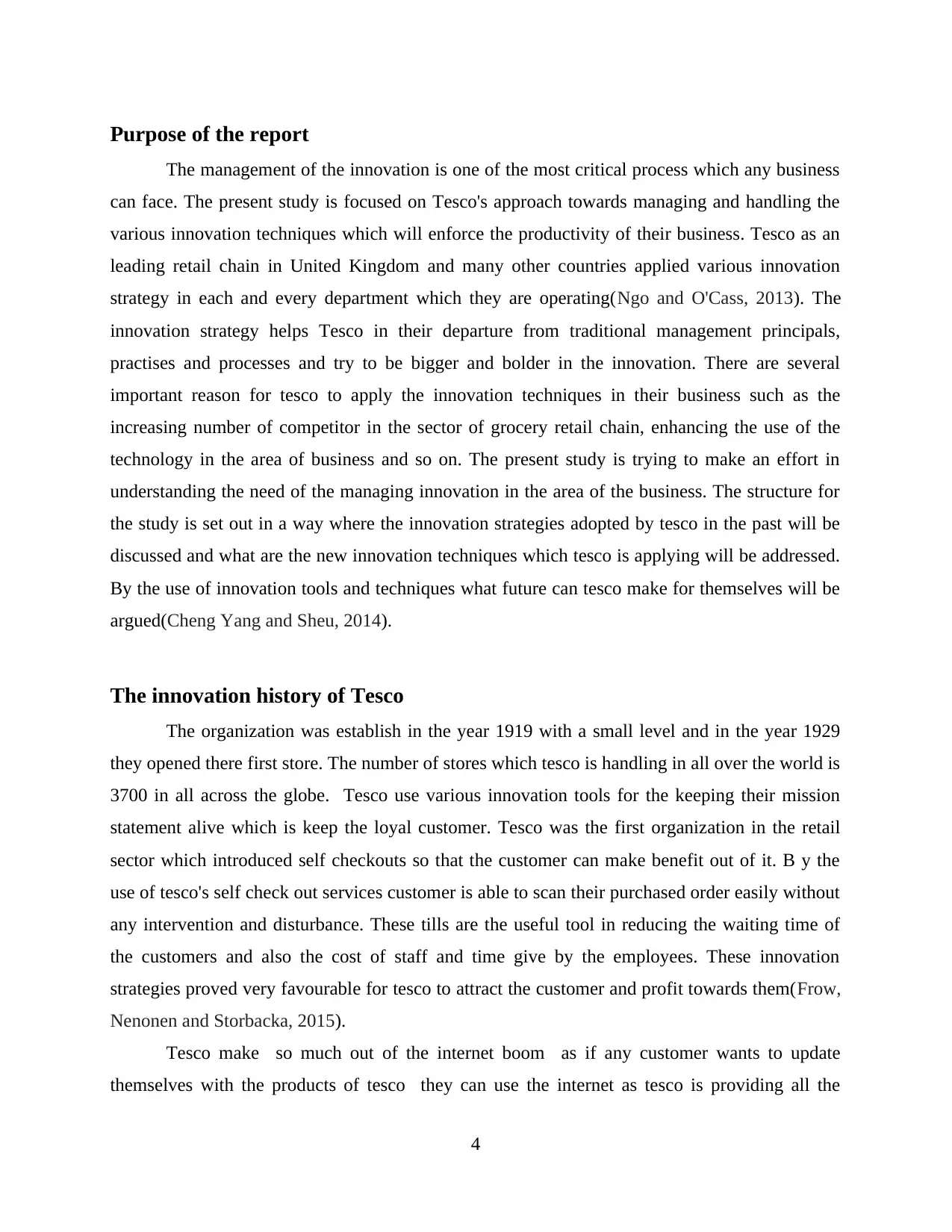
Purpose of the report
The management of the innovation is one of the most critical process which any business
can face. The present study is focused on Tesco's approach towards managing and handling the
various innovation techniques which will enforce the productivity of their business. Tesco as an
leading retail chain in United Kingdom and many other countries applied various innovation
strategy in each and every department which they are operating(Ngo and O'Cass, 2013). The
innovation strategy helps Tesco in their departure from traditional management principals,
practises and processes and try to be bigger and bolder in the innovation. There are several
important reason for tesco to apply the innovation techniques in their business such as the
increasing number of competitor in the sector of grocery retail chain, enhancing the use of the
technology in the area of business and so on. The present study is trying to make an effort in
understanding the need of the managing innovation in the area of the business. The structure for
the study is set out in a way where the innovation strategies adopted by tesco in the past will be
discussed and what are the new innovation techniques which tesco is applying will be addressed.
By the use of innovation tools and techniques what future can tesco make for themselves will be
argued(Cheng Yang and Sheu, 2014).
The innovation history of Tesco
The organization was establish in the year 1919 with a small level and in the year 1929
they opened there first store. The number of stores which tesco is handling in all over the world is
3700 in all across the globe. Tesco use various innovation tools for the keeping their mission
statement alive which is keep the loyal customer. Tesco was the first organization in the retail
sector which introduced self checkouts so that the customer can make benefit out of it. B y the
use of tesco's self check out services customer is able to scan their purchased order easily without
any intervention and disturbance. These tills are the useful tool in reducing the waiting time of
the customers and also the cost of staff and time give by the employees. These innovation
strategies proved very favourable for tesco to attract the customer and profit towards them(Frow,
Nenonen and Storbacka, 2015).
Tesco make so much out of the internet boom as if any customer wants to update
themselves with the products of tesco they can use the internet as tesco is providing all the
4
The management of the innovation is one of the most critical process which any business
can face. The present study is focused on Tesco's approach towards managing and handling the
various innovation techniques which will enforce the productivity of their business. Tesco as an
leading retail chain in United Kingdom and many other countries applied various innovation
strategy in each and every department which they are operating(Ngo and O'Cass, 2013). The
innovation strategy helps Tesco in their departure from traditional management principals,
practises and processes and try to be bigger and bolder in the innovation. There are several
important reason for tesco to apply the innovation techniques in their business such as the
increasing number of competitor in the sector of grocery retail chain, enhancing the use of the
technology in the area of business and so on. The present study is trying to make an effort in
understanding the need of the managing innovation in the area of the business. The structure for
the study is set out in a way where the innovation strategies adopted by tesco in the past will be
discussed and what are the new innovation techniques which tesco is applying will be addressed.
By the use of innovation tools and techniques what future can tesco make for themselves will be
argued(Cheng Yang and Sheu, 2014).
The innovation history of Tesco
The organization was establish in the year 1919 with a small level and in the year 1929
they opened there first store. The number of stores which tesco is handling in all over the world is
3700 in all across the globe. Tesco use various innovation tools for the keeping their mission
statement alive which is keep the loyal customer. Tesco was the first organization in the retail
sector which introduced self checkouts so that the customer can make benefit out of it. B y the
use of tesco's self check out services customer is able to scan their purchased order easily without
any intervention and disturbance. These tills are the useful tool in reducing the waiting time of
the customers and also the cost of staff and time give by the employees. These innovation
strategies proved very favourable for tesco to attract the customer and profit towards them(Frow,
Nenonen and Storbacka, 2015).
Tesco make so much out of the internet boom as if any customer wants to update
themselves with the products of tesco they can use the internet as tesco is providing all the
4
Paraphrase This Document
Need a fresh take? Get an instant paraphrase of this document with our AI Paraphraser
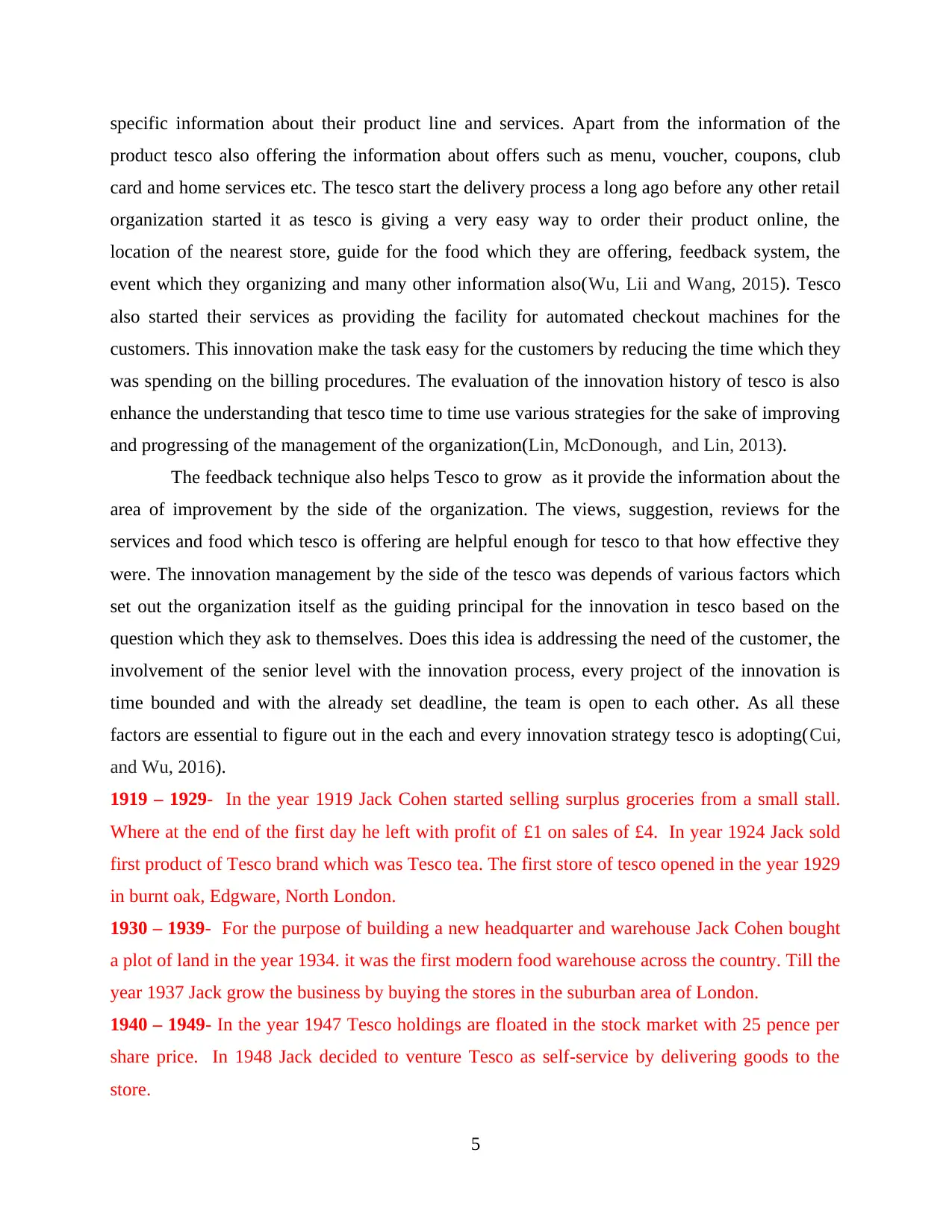
specific information about their product line and services. Apart from the information of the
product tesco also offering the information about offers such as menu, voucher, coupons, club
card and home services etc. The tesco start the delivery process a long ago before any other retail
organization started it as tesco is giving a very easy way to order their product online, the
location of the nearest store, guide for the food which they are offering, feedback system, the
event which they organizing and many other information also(Wu, Lii and Wang, 2015). Tesco
also started their services as providing the facility for automated checkout machines for the
customers. This innovation make the task easy for the customers by reducing the time which they
was spending on the billing procedures. The evaluation of the innovation history of tesco is also
enhance the understanding that tesco time to time use various strategies for the sake of improving
and progressing of the management of the organization(Lin, McDonough, and Lin, 2013).
The feedback technique also helps Tesco to grow as it provide the information about the
area of improvement by the side of the organization. The views, suggestion, reviews for the
services and food which tesco is offering are helpful enough for tesco to that how effective they
were. The innovation management by the side of the tesco was depends of various factors which
set out the organization itself as the guiding principal for the innovation in tesco based on the
question which they ask to themselves. Does this idea is addressing the need of the customer, the
involvement of the senior level with the innovation process, every project of the innovation is
time bounded and with the already set deadline, the team is open to each other. As all these
factors are essential to figure out in the each and every innovation strategy tesco is adopting(Cui,
and Wu, 2016).
1919 – 1929- In the year 1919 Jack Cohen started selling surplus groceries from a small stall.
Where at the end of the first day he left with profit of £1 on sales of £4. In year 1924 Jack sold
first product of Tesco brand which was Tesco tea. The first store of tesco opened in the year 1929
in burnt oak, Edgware, North London.
1930 – 1939- For the purpose of building a new headquarter and warehouse Jack Cohen bought
a plot of land in the year 1934. it was the first modern food warehouse across the country. Till the
year 1937 Jack grow the business by buying the stores in the suburban area of London.
1940 – 1949- In the year 1947 Tesco holdings are floated in the stock market with 25 pence per
share price. In 1948 Jack decided to venture Tesco as self-service by delivering goods to the
store.
5
product tesco also offering the information about offers such as menu, voucher, coupons, club
card and home services etc. The tesco start the delivery process a long ago before any other retail
organization started it as tesco is giving a very easy way to order their product online, the
location of the nearest store, guide for the food which they are offering, feedback system, the
event which they organizing and many other information also(Wu, Lii and Wang, 2015). Tesco
also started their services as providing the facility for automated checkout machines for the
customers. This innovation make the task easy for the customers by reducing the time which they
was spending on the billing procedures. The evaluation of the innovation history of tesco is also
enhance the understanding that tesco time to time use various strategies for the sake of improving
and progressing of the management of the organization(Lin, McDonough, and Lin, 2013).
The feedback technique also helps Tesco to grow as it provide the information about the
area of improvement by the side of the organization. The views, suggestion, reviews for the
services and food which tesco is offering are helpful enough for tesco to that how effective they
were. The innovation management by the side of the tesco was depends of various factors which
set out the organization itself as the guiding principal for the innovation in tesco based on the
question which they ask to themselves. Does this idea is addressing the need of the customer, the
involvement of the senior level with the innovation process, every project of the innovation is
time bounded and with the already set deadline, the team is open to each other. As all these
factors are essential to figure out in the each and every innovation strategy tesco is adopting(Cui,
and Wu, 2016).
1919 – 1929- In the year 1919 Jack Cohen started selling surplus groceries from a small stall.
Where at the end of the first day he left with profit of £1 on sales of £4. In year 1924 Jack sold
first product of Tesco brand which was Tesco tea. The first store of tesco opened in the year 1929
in burnt oak, Edgware, North London.
1930 – 1939- For the purpose of building a new headquarter and warehouse Jack Cohen bought
a plot of land in the year 1934. it was the first modern food warehouse across the country. Till the
year 1937 Jack grow the business by buying the stores in the suburban area of London.
1940 – 1949- In the year 1947 Tesco holdings are floated in the stock market with 25 pence per
share price. In 1948 Jack decided to venture Tesco as self-service by delivering goods to the
store.
5
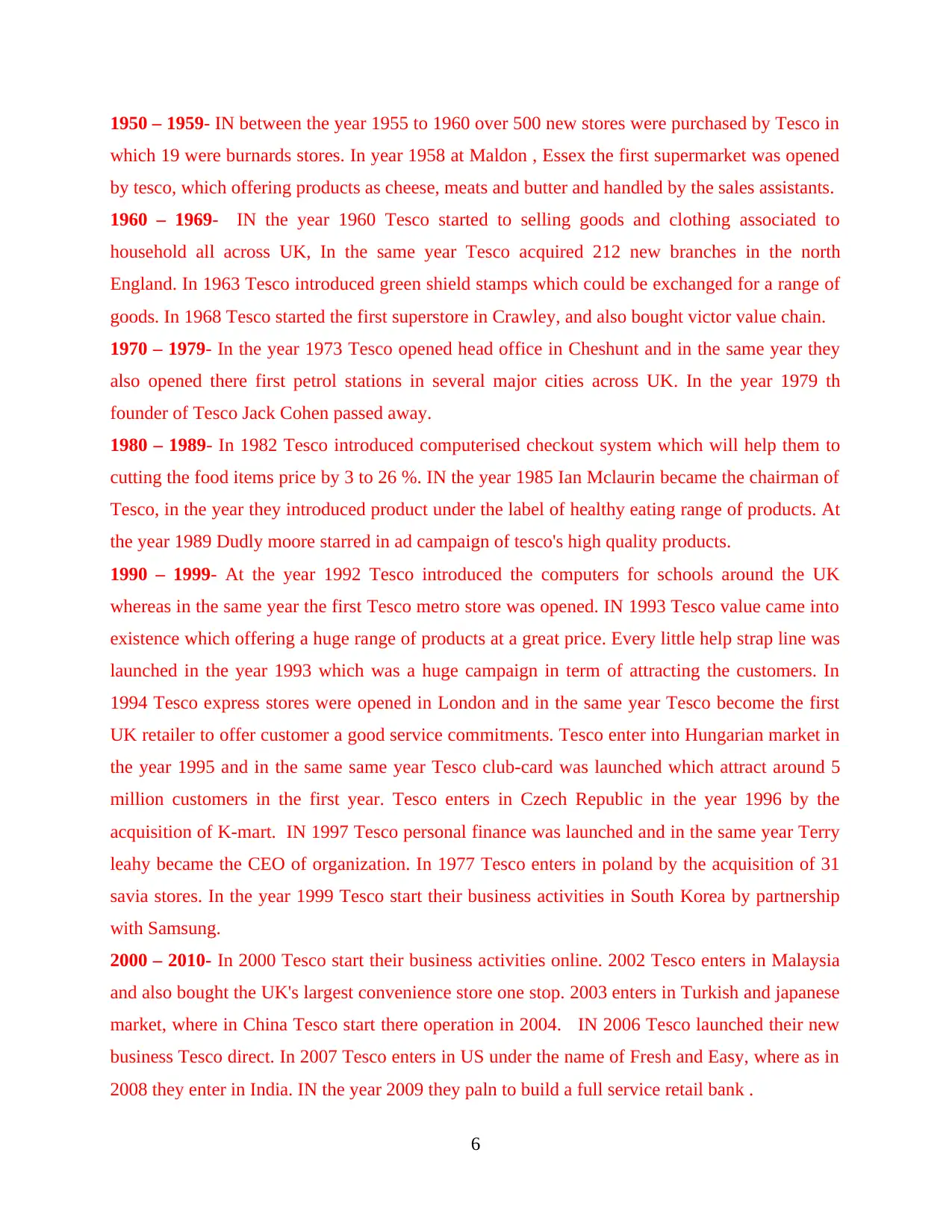
1950 – 1959- IN between the year 1955 to 1960 over 500 new stores were purchased by Tesco in
which 19 were burnards stores. In year 1958 at Maldon , Essex the first supermarket was opened
by tesco, which offering products as cheese, meats and butter and handled by the sales assistants.
1960 – 1969- IN the year 1960 Tesco started to selling goods and clothing associated to
household all across UK, In the same year Tesco acquired 212 new branches in the north
England. In 1963 Tesco introduced green shield stamps which could be exchanged for a range of
goods. In 1968 Tesco started the first superstore in Crawley, and also bought victor value chain.
1970 – 1979- In the year 1973 Tesco opened head office in Cheshunt and in the same year they
also opened there first petrol stations in several major cities across UK. In the year 1979 th
founder of Tesco Jack Cohen passed away.
1980 – 1989- In 1982 Tesco introduced computerised checkout system which will help them to
cutting the food items price by 3 to 26 %. IN the year 1985 Ian Mclaurin became the chairman of
Tesco, in the year they introduced product under the label of healthy eating range of products. At
the year 1989 Dudly moore starred in ad campaign of tesco's high quality products.
1990 – 1999- At the year 1992 Tesco introduced the computers for schools around the UK
whereas in the same year the first Tesco metro store was opened. IN 1993 Tesco value came into
existence which offering a huge range of products at a great price. Every little help strap line was
launched in the year 1993 which was a huge campaign in term of attracting the customers. In
1994 Tesco express stores were opened in London and in the same year Tesco become the first
UK retailer to offer customer a good service commitments. Tesco enter into Hungarian market in
the year 1995 and in the same same year Tesco club-card was launched which attract around 5
million customers in the first year. Tesco enters in Czech Republic in the year 1996 by the
acquisition of K-mart. IN 1997 Tesco personal finance was launched and in the same year Terry
leahy became the CEO of organization. In 1977 Tesco enters in poland by the acquisition of 31
savia stores. In the year 1999 Tesco start their business activities in South Korea by partnership
with Samsung.
2000 – 2010- In 2000 Tesco start their business activities online. 2002 Tesco enters in Malaysia
and also bought the UK's largest convenience store one stop. 2003 enters in Turkish and japanese
market, where in China Tesco start there operation in 2004. IN 2006 Tesco launched their new
business Tesco direct. In 2007 Tesco enters in US under the name of Fresh and Easy, where as in
2008 they enter in India. IN the year 2009 they paln to build a full service retail bank .
6
which 19 were burnards stores. In year 1958 at Maldon , Essex the first supermarket was opened
by tesco, which offering products as cheese, meats and butter and handled by the sales assistants.
1960 – 1969- IN the year 1960 Tesco started to selling goods and clothing associated to
household all across UK, In the same year Tesco acquired 212 new branches in the north
England. In 1963 Tesco introduced green shield stamps which could be exchanged for a range of
goods. In 1968 Tesco started the first superstore in Crawley, and also bought victor value chain.
1970 – 1979- In the year 1973 Tesco opened head office in Cheshunt and in the same year they
also opened there first petrol stations in several major cities across UK. In the year 1979 th
founder of Tesco Jack Cohen passed away.
1980 – 1989- In 1982 Tesco introduced computerised checkout system which will help them to
cutting the food items price by 3 to 26 %. IN the year 1985 Ian Mclaurin became the chairman of
Tesco, in the year they introduced product under the label of healthy eating range of products. At
the year 1989 Dudly moore starred in ad campaign of tesco's high quality products.
1990 – 1999- At the year 1992 Tesco introduced the computers for schools around the UK
whereas in the same year the first Tesco metro store was opened. IN 1993 Tesco value came into
existence which offering a huge range of products at a great price. Every little help strap line was
launched in the year 1993 which was a huge campaign in term of attracting the customers. In
1994 Tesco express stores were opened in London and in the same year Tesco become the first
UK retailer to offer customer a good service commitments. Tesco enter into Hungarian market in
the year 1995 and in the same same year Tesco club-card was launched which attract around 5
million customers in the first year. Tesco enters in Czech Republic in the year 1996 by the
acquisition of K-mart. IN 1997 Tesco personal finance was launched and in the same year Terry
leahy became the CEO of organization. In 1977 Tesco enters in poland by the acquisition of 31
savia stores. In the year 1999 Tesco start their business activities in South Korea by partnership
with Samsung.
2000 – 2010- In 2000 Tesco start their business activities online. 2002 Tesco enters in Malaysia
and also bought the UK's largest convenience store one stop. 2003 enters in Turkish and japanese
market, where in China Tesco start there operation in 2004. IN 2006 Tesco launched their new
business Tesco direct. In 2007 Tesco enters in US under the name of Fresh and Easy, where as in
2008 they enter in India. IN the year 2009 they paln to build a full service retail bank .
6
⊘ This is a preview!⊘
Do you want full access?
Subscribe today to unlock all pages.

Trusted by 1+ million students worldwide
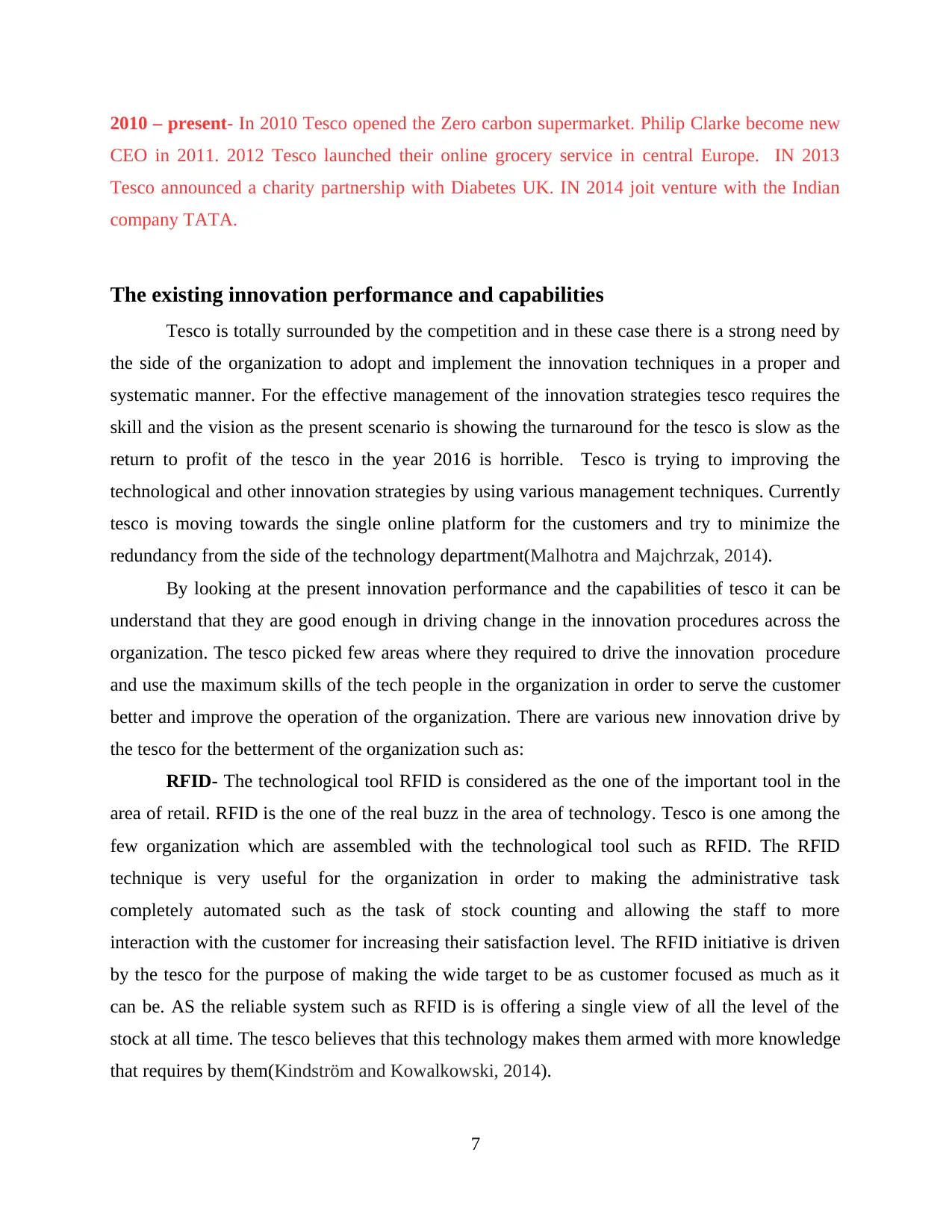
2010 – present- In 2010 Tesco opened the Zero carbon supermarket. Philip Clarke become new
CEO in 2011. 2012 Tesco launched their online grocery service in central Europe. IN 2013
Tesco announced a charity partnership with Diabetes UK. IN 2014 joit venture with the Indian
company TATA.
The existing innovation performance and capabilities
Tesco is totally surrounded by the competition and in these case there is a strong need by
the side of the organization to adopt and implement the innovation techniques in a proper and
systematic manner. For the effective management of the innovation strategies tesco requires the
skill and the vision as the present scenario is showing the turnaround for the tesco is slow as the
return to profit of the tesco in the year 2016 is horrible. Tesco is trying to improving the
technological and other innovation strategies by using various management techniques. Currently
tesco is moving towards the single online platform for the customers and try to minimize the
redundancy from the side of the technology department(Malhotra and Majchrzak, 2014).
By looking at the present innovation performance and the capabilities of tesco it can be
understand that they are good enough in driving change in the innovation procedures across the
organization. The tesco picked few areas where they required to drive the innovation procedure
and use the maximum skills of the tech people in the organization in order to serve the customer
better and improve the operation of the organization. There are various new innovation drive by
the tesco for the betterment of the organization such as:
RFID- The technological tool RFID is considered as the one of the important tool in the
area of retail. RFID is the one of the real buzz in the area of technology. Tesco is one among the
few organization which are assembled with the technological tool such as RFID. The RFID
technique is very useful for the organization in order to making the administrative task
completely automated such as the task of stock counting and allowing the staff to more
interaction with the customer for increasing their satisfaction level. The RFID initiative is driven
by the tesco for the purpose of making the wide target to be as customer focused as much as it
can be. AS the reliable system such as RFID is is offering a single view of all the level of the
stock at all time. The tesco believes that this technology makes them armed with more knowledge
that requires by them(Kindström and Kowalkowski, 2014).
7
CEO in 2011. 2012 Tesco launched their online grocery service in central Europe. IN 2013
Tesco announced a charity partnership with Diabetes UK. IN 2014 joit venture with the Indian
company TATA.
The existing innovation performance and capabilities
Tesco is totally surrounded by the competition and in these case there is a strong need by
the side of the organization to adopt and implement the innovation techniques in a proper and
systematic manner. For the effective management of the innovation strategies tesco requires the
skill and the vision as the present scenario is showing the turnaround for the tesco is slow as the
return to profit of the tesco in the year 2016 is horrible. Tesco is trying to improving the
technological and other innovation strategies by using various management techniques. Currently
tesco is moving towards the single online platform for the customers and try to minimize the
redundancy from the side of the technology department(Malhotra and Majchrzak, 2014).
By looking at the present innovation performance and the capabilities of tesco it can be
understand that they are good enough in driving change in the innovation procedures across the
organization. The tesco picked few areas where they required to drive the innovation procedure
and use the maximum skills of the tech people in the organization in order to serve the customer
better and improve the operation of the organization. There are various new innovation drive by
the tesco for the betterment of the organization such as:
RFID- The technological tool RFID is considered as the one of the important tool in the
area of retail. RFID is the one of the real buzz in the area of technology. Tesco is one among the
few organization which are assembled with the technological tool such as RFID. The RFID
technique is very useful for the organization in order to making the administrative task
completely automated such as the task of stock counting and allowing the staff to more
interaction with the customer for increasing their satisfaction level. The RFID initiative is driven
by the tesco for the purpose of making the wide target to be as customer focused as much as it
can be. AS the reliable system such as RFID is is offering a single view of all the level of the
stock at all time. The tesco believes that this technology makes them armed with more knowledge
that requires by them(Kindström and Kowalkowski, 2014).
7
Paraphrase This Document
Need a fresh take? Get an instant paraphrase of this document with our AI Paraphraser
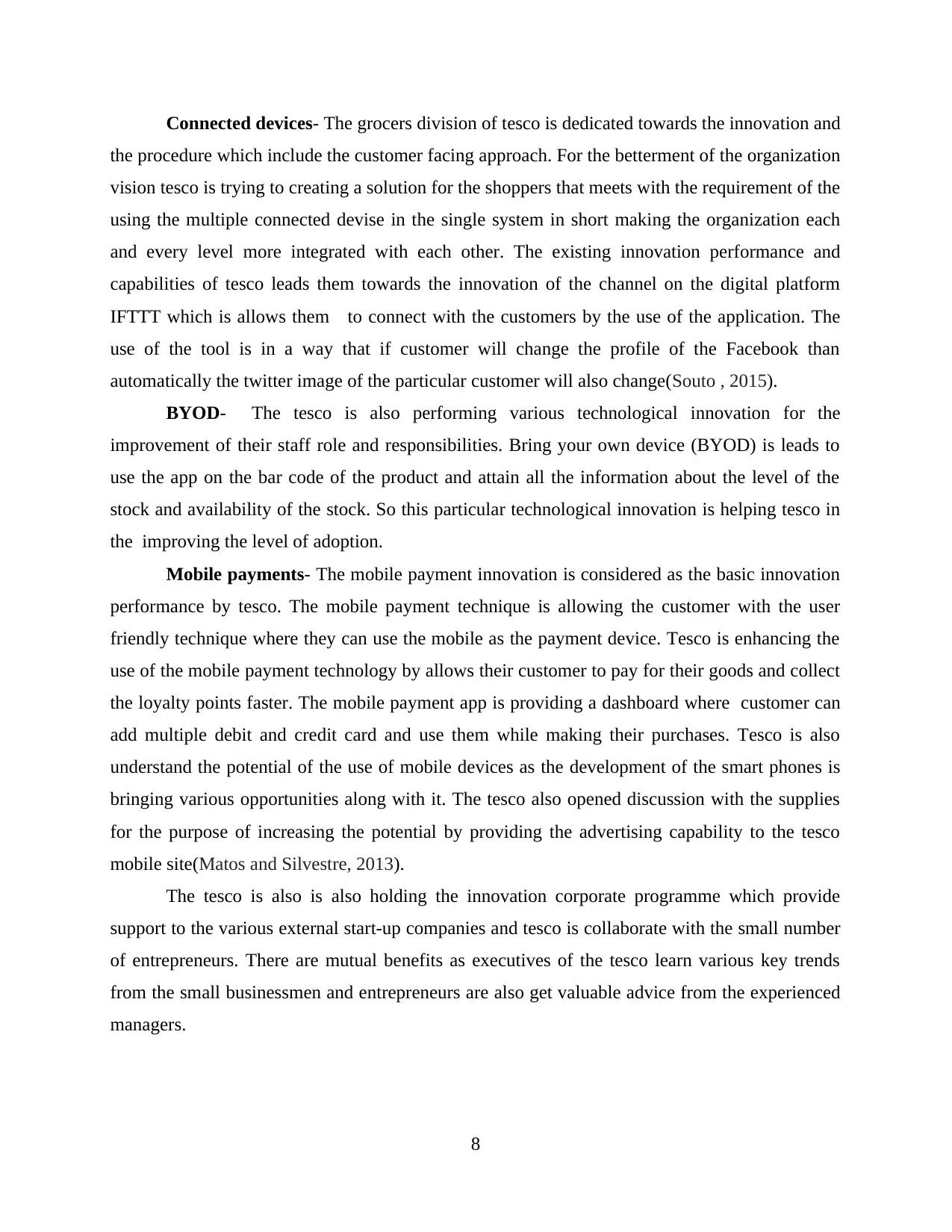
Connected devices- The grocers division of tesco is dedicated towards the innovation and
the procedure which include the customer facing approach. For the betterment of the organization
vision tesco is trying to creating a solution for the shoppers that meets with the requirement of the
using the multiple connected devise in the single system in short making the organization each
and every level more integrated with each other. The existing innovation performance and
capabilities of tesco leads them towards the innovation of the channel on the digital platform
IFTTT which is allows them to connect with the customers by the use of the application. The
use of the tool is in a way that if customer will change the profile of the Facebook than
automatically the twitter image of the particular customer will also change(Souto , 2015).
BYOD- The tesco is also performing various technological innovation for the
improvement of their staff role and responsibilities. Bring your own device (BYOD) is leads to
use the app on the bar code of the product and attain all the information about the level of the
stock and availability of the stock. So this particular technological innovation is helping tesco in
the improving the level of adoption.
Mobile payments- The mobile payment innovation is considered as the basic innovation
performance by tesco. The mobile payment technique is allowing the customer with the user
friendly technique where they can use the mobile as the payment device. Tesco is enhancing the
use of the mobile payment technology by allows their customer to pay for their goods and collect
the loyalty points faster. The mobile payment app is providing a dashboard where customer can
add multiple debit and credit card and use them while making their purchases. Tesco is also
understand the potential of the use of mobile devices as the development of the smart phones is
bringing various opportunities along with it. The tesco also opened discussion with the supplies
for the purpose of increasing the potential by providing the advertising capability to the tesco
mobile site(Matos and Silvestre, 2013).
The tesco is also is also holding the innovation corporate programme which provide
support to the various external start-up companies and tesco is collaborate with the small number
of entrepreneurs. There are mutual benefits as executives of the tesco learn various key trends
from the small businessmen and entrepreneurs are also get valuable advice from the experienced
managers.
8
the procedure which include the customer facing approach. For the betterment of the organization
vision tesco is trying to creating a solution for the shoppers that meets with the requirement of the
using the multiple connected devise in the single system in short making the organization each
and every level more integrated with each other. The existing innovation performance and
capabilities of tesco leads them towards the innovation of the channel on the digital platform
IFTTT which is allows them to connect with the customers by the use of the application. The
use of the tool is in a way that if customer will change the profile of the Facebook than
automatically the twitter image of the particular customer will also change(Souto , 2015).
BYOD- The tesco is also performing various technological innovation for the
improvement of their staff role and responsibilities. Bring your own device (BYOD) is leads to
use the app on the bar code of the product and attain all the information about the level of the
stock and availability of the stock. So this particular technological innovation is helping tesco in
the improving the level of adoption.
Mobile payments- The mobile payment innovation is considered as the basic innovation
performance by tesco. The mobile payment technique is allowing the customer with the user
friendly technique where they can use the mobile as the payment device. Tesco is enhancing the
use of the mobile payment technology by allows their customer to pay for their goods and collect
the loyalty points faster. The mobile payment app is providing a dashboard where customer can
add multiple debit and credit card and use them while making their purchases. Tesco is also
understand the potential of the use of mobile devices as the development of the smart phones is
bringing various opportunities along with it. The tesco also opened discussion with the supplies
for the purpose of increasing the potential by providing the advertising capability to the tesco
mobile site(Matos and Silvestre, 2013).
The tesco is also is also holding the innovation corporate programme which provide
support to the various external start-up companies and tesco is collaborate with the small number
of entrepreneurs. There are mutual benefits as executives of the tesco learn various key trends
from the small businessmen and entrepreneurs are also get valuable advice from the experienced
managers.
8
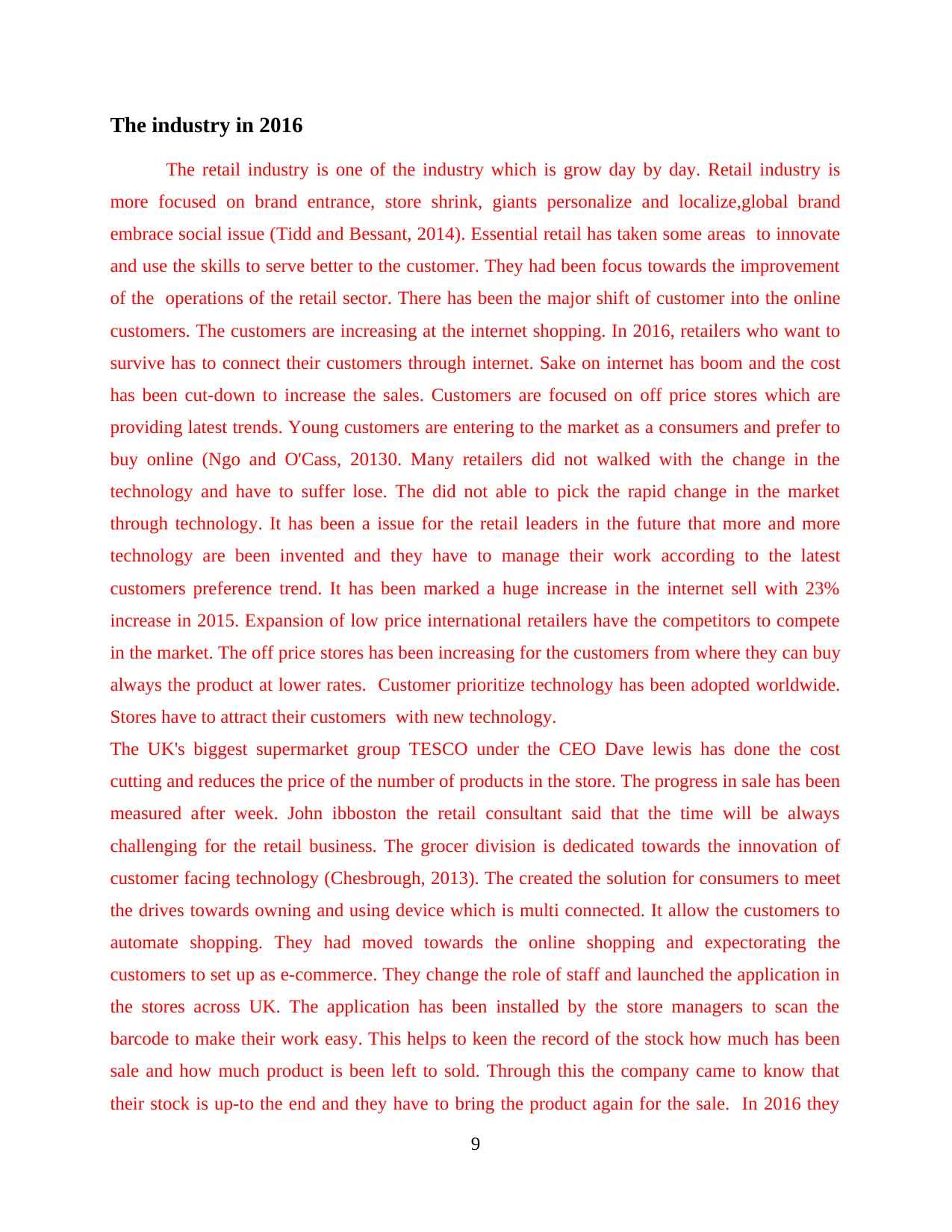
The industry in 2016
The retail industry is one of the industry which is grow day by day. Retail industry is
more focused on brand entrance, store shrink, giants personalize and localize,global brand
embrace social issue (Tidd and Bessant, 2014). Essential retail has taken some areas to innovate
and use the skills to serve better to the customer. They had been focus towards the improvement
of the operations of the retail sector. There has been the major shift of customer into the online
customers. The customers are increasing at the internet shopping. In 2016, retailers who want to
survive has to connect their customers through internet. Sake on internet has boom and the cost
has been cut-down to increase the sales. Customers are focused on off price stores which are
providing latest trends. Young customers are entering to the market as a consumers and prefer to
buy online (Ngo and O'Cass, 20130. Many retailers did not walked with the change in the
technology and have to suffer lose. The did not able to pick the rapid change in the market
through technology. It has been a issue for the retail leaders in the future that more and more
technology are been invented and they have to manage their work according to the latest
customers preference trend. It has been marked a huge increase in the internet sell with 23%
increase in 2015. Expansion of low price international retailers have the competitors to compete
in the market. The off price stores has been increasing for the customers from where they can buy
always the product at lower rates. Customer prioritize technology has been adopted worldwide.
Stores have to attract their customers with new technology.
The UK's biggest supermarket group TESCO under the CEO Dave lewis has done the cost
cutting and reduces the price of the number of products in the store. The progress in sale has been
measured after week. John ibboston the retail consultant said that the time will be always
challenging for the retail business. The grocer division is dedicated towards the innovation of
customer facing technology (Chesbrough, 2013). The created the solution for consumers to meet
the drives towards owning and using device which is multi connected. It allow the customers to
automate shopping. They had moved towards the online shopping and expectorating the
customers to set up as e-commerce. They change the role of staff and launched the application in
the stores across UK. The application has been installed by the store managers to scan the
barcode to make their work easy. This helps to keen the record of the stock how much has been
sale and how much product is been left to sold. Through this the company came to know that
their stock is up-to the end and they have to bring the product again for the sale. In 2016 they
9
The retail industry is one of the industry which is grow day by day. Retail industry is
more focused on brand entrance, store shrink, giants personalize and localize,global brand
embrace social issue (Tidd and Bessant, 2014). Essential retail has taken some areas to innovate
and use the skills to serve better to the customer. They had been focus towards the improvement
of the operations of the retail sector. There has been the major shift of customer into the online
customers. The customers are increasing at the internet shopping. In 2016, retailers who want to
survive has to connect their customers through internet. Sake on internet has boom and the cost
has been cut-down to increase the sales. Customers are focused on off price stores which are
providing latest trends. Young customers are entering to the market as a consumers and prefer to
buy online (Ngo and O'Cass, 20130. Many retailers did not walked with the change in the
technology and have to suffer lose. The did not able to pick the rapid change in the market
through technology. It has been a issue for the retail leaders in the future that more and more
technology are been invented and they have to manage their work according to the latest
customers preference trend. It has been marked a huge increase in the internet sell with 23%
increase in 2015. Expansion of low price international retailers have the competitors to compete
in the market. The off price stores has been increasing for the customers from where they can buy
always the product at lower rates. Customer prioritize technology has been adopted worldwide.
Stores have to attract their customers with new technology.
The UK's biggest supermarket group TESCO under the CEO Dave lewis has done the cost
cutting and reduces the price of the number of products in the store. The progress in sale has been
measured after week. John ibboston the retail consultant said that the time will be always
challenging for the retail business. The grocer division is dedicated towards the innovation of
customer facing technology (Chesbrough, 2013). The created the solution for consumers to meet
the drives towards owning and using device which is multi connected. It allow the customers to
automate shopping. They had moved towards the online shopping and expectorating the
customers to set up as e-commerce. They change the role of staff and launched the application in
the stores across UK. The application has been installed by the store managers to scan the
barcode to make their work easy. This helps to keen the record of the stock how much has been
sale and how much product is been left to sold. Through this the company came to know that
their stock is up-to the end and they have to bring the product again for the sale. In 2016 they
9
⊘ This is a preview!⊘
Do you want full access?
Subscribe today to unlock all pages.

Trusted by 1+ million students worldwide
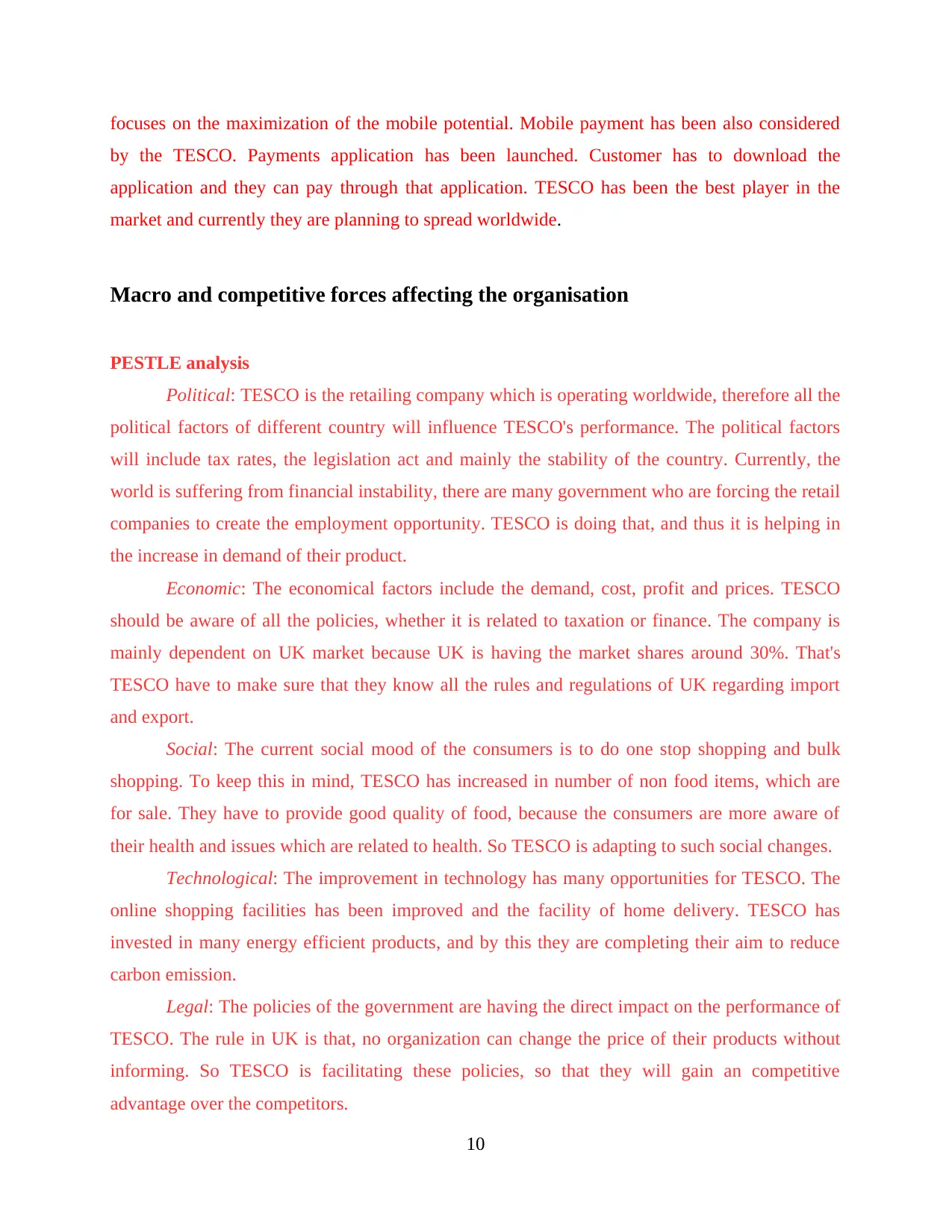
focuses on the maximization of the mobile potential. Mobile payment has been also considered
by the TESCO. Payments application has been launched. Customer has to download the
application and they can pay through that application. TESCO has been the best player in the
market and currently they are planning to spread worldwide.
Macro and competitive forces affecting the organisation
PESTLE analysis
Political: TESCO is the retailing company which is operating worldwide, therefore all the
political factors of different country will influence TESCO's performance. The political factors
will include tax rates, the legislation act and mainly the stability of the country. Currently, the
world is suffering from financial instability, there are many government who are forcing the retail
companies to create the employment opportunity. TESCO is doing that, and thus it is helping in
the increase in demand of their product.
Economic: The economical factors include the demand, cost, profit and prices. TESCO
should be aware of all the policies, whether it is related to taxation or finance. The company is
mainly dependent on UK market because UK is having the market shares around 30%. That's
TESCO have to make sure that they know all the rules and regulations of UK regarding import
and export.
Social: The current social mood of the consumers is to do one stop shopping and bulk
shopping. To keep this in mind, TESCO has increased in number of non food items, which are
for sale. They have to provide good quality of food, because the consumers are more aware of
their health and issues which are related to health. So TESCO is adapting to such social changes.
Technological: The improvement in technology has many opportunities for TESCO. The
online shopping facilities has been improved and the facility of home delivery. TESCO has
invested in many energy efficient products, and by this they are completing their aim to reduce
carbon emission.
Legal: The policies of the government are having the direct impact on the performance of
TESCO. The rule in UK is that, no organization can change the price of their products without
informing. So TESCO is facilitating these policies, so that they will gain an competitive
advantage over the competitors.
10
by the TESCO. Payments application has been launched. Customer has to download the
application and they can pay through that application. TESCO has been the best player in the
market and currently they are planning to spread worldwide.
Macro and competitive forces affecting the organisation
PESTLE analysis
Political: TESCO is the retailing company which is operating worldwide, therefore all the
political factors of different country will influence TESCO's performance. The political factors
will include tax rates, the legislation act and mainly the stability of the country. Currently, the
world is suffering from financial instability, there are many government who are forcing the retail
companies to create the employment opportunity. TESCO is doing that, and thus it is helping in
the increase in demand of their product.
Economic: The economical factors include the demand, cost, profit and prices. TESCO
should be aware of all the policies, whether it is related to taxation or finance. The company is
mainly dependent on UK market because UK is having the market shares around 30%. That's
TESCO have to make sure that they know all the rules and regulations of UK regarding import
and export.
Social: The current social mood of the consumers is to do one stop shopping and bulk
shopping. To keep this in mind, TESCO has increased in number of non food items, which are
for sale. They have to provide good quality of food, because the consumers are more aware of
their health and issues which are related to health. So TESCO is adapting to such social changes.
Technological: The improvement in technology has many opportunities for TESCO. The
online shopping facilities has been improved and the facility of home delivery. TESCO has
invested in many energy efficient products, and by this they are completing their aim to reduce
carbon emission.
Legal: The policies of the government are having the direct impact on the performance of
TESCO. The rule in UK is that, no organization can change the price of their products without
informing. So TESCO is facilitating these policies, so that they will gain an competitive
advantage over the competitors.
10
Paraphrase This Document
Need a fresh take? Get an instant paraphrase of this document with our AI Paraphraser
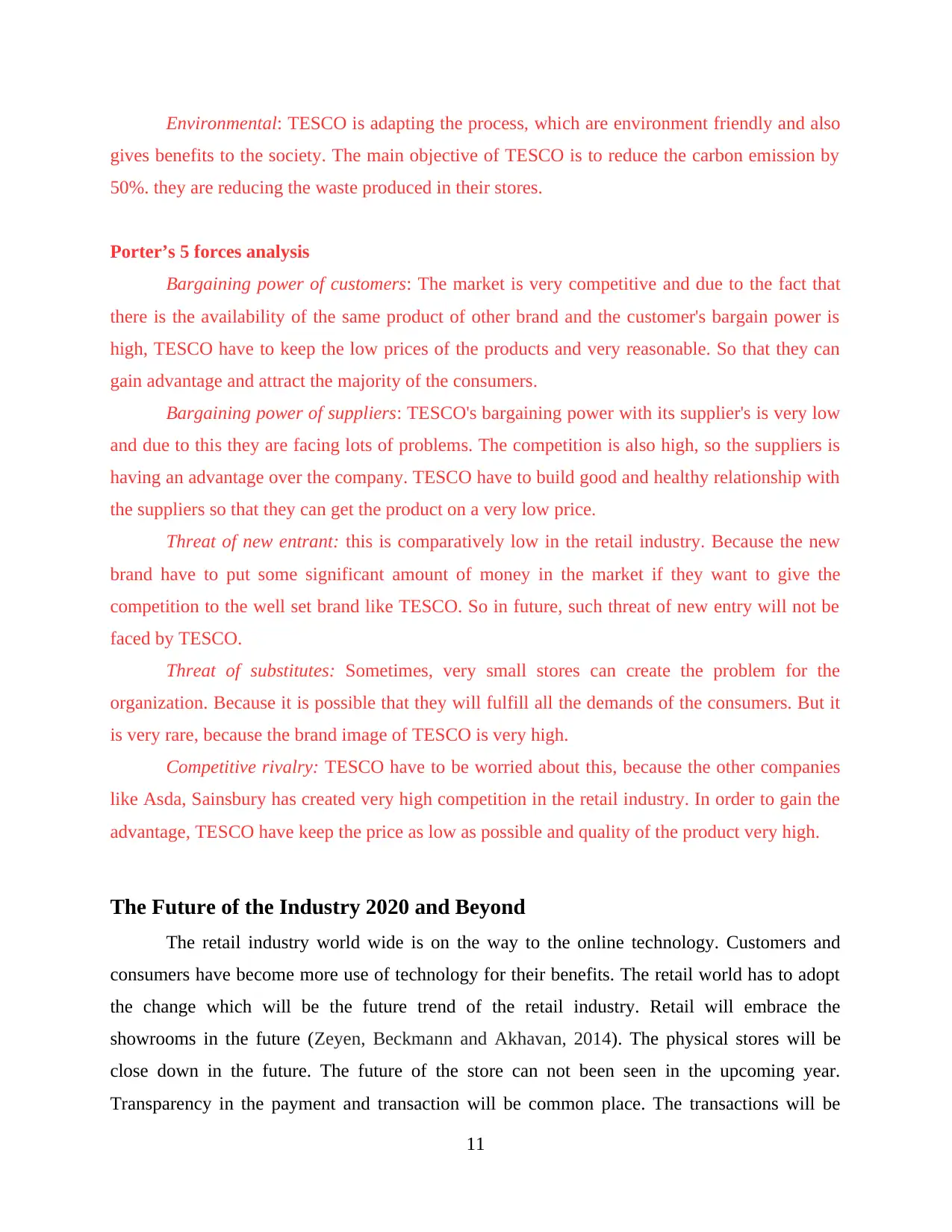
Environmental: TESCO is adapting the process, which are environment friendly and also
gives benefits to the society. The main objective of TESCO is to reduce the carbon emission by
50%. they are reducing the waste produced in their stores.
Porter’s 5 forces analysis
Bargaining power of customers: The market is very competitive and due to the fact that
there is the availability of the same product of other brand and the customer's bargain power is
high, TESCO have to keep the low prices of the products and very reasonable. So that they can
gain advantage and attract the majority of the consumers.
Bargaining power of suppliers: TESCO's bargaining power with its supplier's is very low
and due to this they are facing lots of problems. The competition is also high, so the suppliers is
having an advantage over the company. TESCO have to build good and healthy relationship with
the suppliers so that they can get the product on a very low price.
Threat of new entrant: this is comparatively low in the retail industry. Because the new
brand have to put some significant amount of money in the market if they want to give the
competition to the well set brand like TESCO. So in future, such threat of new entry will not be
faced by TESCO.
Threat of substitutes: Sometimes, very small stores can create the problem for the
organization. Because it is possible that they will fulfill all the demands of the consumers. But it
is very rare, because the brand image of TESCO is very high.
Competitive rivalry: TESCO have to be worried about this, because the other companies
like Asda, Sainsbury has created very high competition in the retail industry. In order to gain the
advantage, TESCO have keep the price as low as possible and quality of the product very high.
The Future of the Industry 2020 and Beyond
The retail industry world wide is on the way to the online technology. Customers and
consumers have become more use of technology for their benefits. The retail world has to adopt
the change which will be the future trend of the retail industry. Retail will embrace the
showrooms in the future (Zeyen, Beckmann and Akhavan, 2014). The physical stores will be
close down in the future. The future of the store can not been seen in the upcoming year.
Transparency in the payment and transaction will be common place. The transactions will be
11
gives benefits to the society. The main objective of TESCO is to reduce the carbon emission by
50%. they are reducing the waste produced in their stores.
Porter’s 5 forces analysis
Bargaining power of customers: The market is very competitive and due to the fact that
there is the availability of the same product of other brand and the customer's bargain power is
high, TESCO have to keep the low prices of the products and very reasonable. So that they can
gain advantage and attract the majority of the consumers.
Bargaining power of suppliers: TESCO's bargaining power with its supplier's is very low
and due to this they are facing lots of problems. The competition is also high, so the suppliers is
having an advantage over the company. TESCO have to build good and healthy relationship with
the suppliers so that they can get the product on a very low price.
Threat of new entrant: this is comparatively low in the retail industry. Because the new
brand have to put some significant amount of money in the market if they want to give the
competition to the well set brand like TESCO. So in future, such threat of new entry will not be
faced by TESCO.
Threat of substitutes: Sometimes, very small stores can create the problem for the
organization. Because it is possible that they will fulfill all the demands of the consumers. But it
is very rare, because the brand image of TESCO is very high.
Competitive rivalry: TESCO have to be worried about this, because the other companies
like Asda, Sainsbury has created very high competition in the retail industry. In order to gain the
advantage, TESCO have keep the price as low as possible and quality of the product very high.
The Future of the Industry 2020 and Beyond
The retail industry world wide is on the way to the online technology. Customers and
consumers have become more use of technology for their benefits. The retail world has to adopt
the change which will be the future trend of the retail industry. Retail will embrace the
showrooms in the future (Zeyen, Beckmann and Akhavan, 2014). The physical stores will be
close down in the future. The future of the store can not been seen in the upcoming year.
Transparency in the payment and transaction will be common place. The transactions will be
11
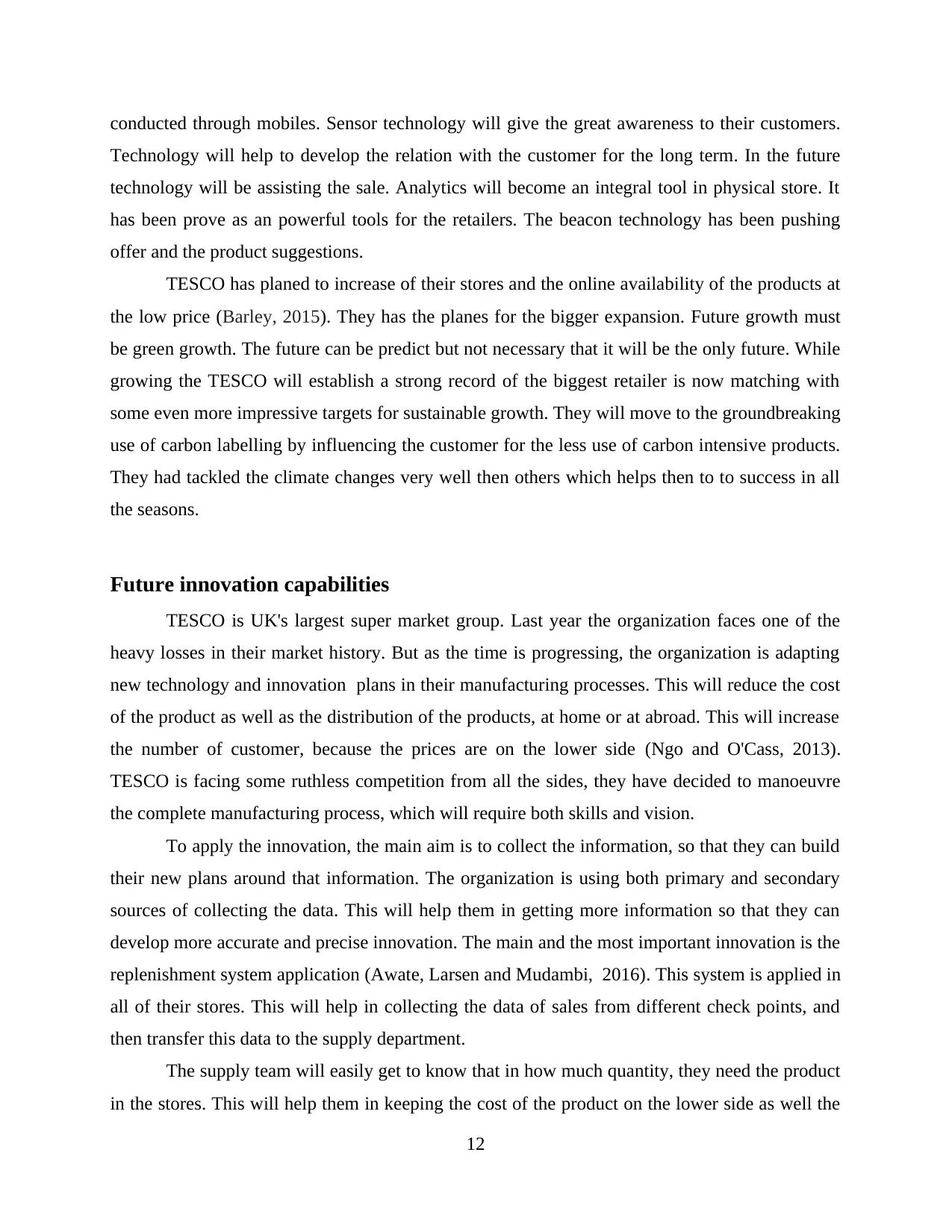
conducted through mobiles. Sensor technology will give the great awareness to their customers.
Technology will help to develop the relation with the customer for the long term. In the future
technology will be assisting the sale. Analytics will become an integral tool in physical store. It
has been prove as an powerful tools for the retailers. The beacon technology has been pushing
offer and the product suggestions.
TESCO has planed to increase of their stores and the online availability of the products at
the low price (Barley, 2015). They has the planes for the bigger expansion. Future growth must
be green growth. The future can be predict but not necessary that it will be the only future. While
growing the TESCO will establish a strong record of the biggest retailer is now matching with
some even more impressive targets for sustainable growth. They will move to the groundbreaking
use of carbon labelling by influencing the customer for the less use of carbon intensive products.
They had tackled the climate changes very well then others which helps then to to success in all
the seasons.
Future innovation capabilities
TESCO is UK's largest super market group. Last year the organization faces one of the
heavy losses in their market history. But as the time is progressing, the organization is adapting
new technology and innovation plans in their manufacturing processes. This will reduce the cost
of the product as well as the distribution of the products, at home or at abroad. This will increase
the number of customer, because the prices are on the lower side (Ngo and O'Cass, 2013).
TESCO is facing some ruthless competition from all the sides, they have decided to manoeuvre
the complete manufacturing process, which will require both skills and vision.
To apply the innovation, the main aim is to collect the information, so that they can build
their new plans around that information. The organization is using both primary and secondary
sources of collecting the data. This will help them in getting more information so that they can
develop more accurate and precise innovation. The main and the most important innovation is the
replenishment system application (Awate, Larsen and Mudambi, 2016). This system is applied in
all of their stores. This will help in collecting the data of sales from different check points, and
then transfer this data to the supply department.
The supply team will easily get to know that in how much quantity, they need the product
in the stores. This will help them in keeping the cost of the product on the lower side as well the
12
Technology will help to develop the relation with the customer for the long term. In the future
technology will be assisting the sale. Analytics will become an integral tool in physical store. It
has been prove as an powerful tools for the retailers. The beacon technology has been pushing
offer and the product suggestions.
TESCO has planed to increase of their stores and the online availability of the products at
the low price (Barley, 2015). They has the planes for the bigger expansion. Future growth must
be green growth. The future can be predict but not necessary that it will be the only future. While
growing the TESCO will establish a strong record of the biggest retailer is now matching with
some even more impressive targets for sustainable growth. They will move to the groundbreaking
use of carbon labelling by influencing the customer for the less use of carbon intensive products.
They had tackled the climate changes very well then others which helps then to to success in all
the seasons.
Future innovation capabilities
TESCO is UK's largest super market group. Last year the organization faces one of the
heavy losses in their market history. But as the time is progressing, the organization is adapting
new technology and innovation plans in their manufacturing processes. This will reduce the cost
of the product as well as the distribution of the products, at home or at abroad. This will increase
the number of customer, because the prices are on the lower side (Ngo and O'Cass, 2013).
TESCO is facing some ruthless competition from all the sides, they have decided to manoeuvre
the complete manufacturing process, which will require both skills and vision.
To apply the innovation, the main aim is to collect the information, so that they can build
their new plans around that information. The organization is using both primary and secondary
sources of collecting the data. This will help them in getting more information so that they can
develop more accurate and precise innovation. The main and the most important innovation is the
replenishment system application (Awate, Larsen and Mudambi, 2016). This system is applied in
all of their stores. This will help in collecting the data of sales from different check points, and
then transfer this data to the supply department.
The supply team will easily get to know that in how much quantity, they need the product
in the stores. This will help them in keeping the cost of the product on the lower side as well the
12
⊘ This is a preview!⊘
Do you want full access?
Subscribe today to unlock all pages.

Trusted by 1+ million students worldwide
1 out of 20
Related Documents
Your All-in-One AI-Powered Toolkit for Academic Success.
+13062052269
info@desklib.com
Available 24*7 on WhatsApp / Email
![[object Object]](/_next/static/media/star-bottom.7253800d.svg)
Unlock your academic potential
Copyright © 2020–2025 A2Z Services. All Rights Reserved. Developed and managed by ZUCOL.





